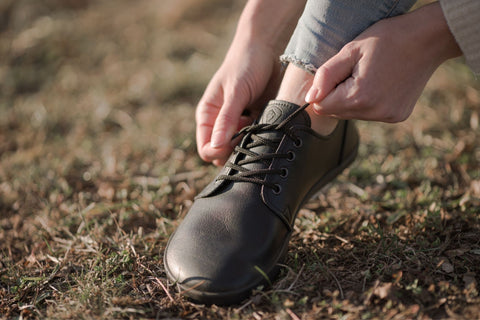How to walk healthy: 5+ tips from physiotherapists
Since childhood, we’ve all learned to walk in non-anatomical shoes. Now‘s the time to liberate your feet and acquaint them with healthy walking.
We’re glad that you’re here and want to learn with us. But be warned: This article is likely to debunk several myths that you’ve probably heard about walking.

Ready to learn how to walk healthy?
Why should you be interested in healthy walking?
Why should you change the way you walk and how often you do it after all these years? The benefits might surprise you.
- Healthy walking will straighten your posture. It can help with back pain, as it has a positive effect on the whole body.
- With a healthy stride, the chest will naturally open up. You’ll be breathing deeply, which will oxidize your organism.
- Healthy walking benefits your immunity. We’ve written about this before in the article Barefoot and immunity: Taking your shoes off for health?
- Healthy walking activates the pelvic floor. You can read more about this in the article on How to strengthen the pelvic floor.
- When walking naturally in the right shoes, you stimulate your corresponding brain centers. This can literally improve your mood.
- Walking is a movement that we’ve evolved to do. It’s a natural movement. When walking, the spine is straightened and the body is naturally engaged – this is why it’s beneficial after a day of sitting in the office.
- Healthy walking can make you fit – and everyone can do it.
Natural walking is the best exercise. You don’t have to walk hundreds of kilometers a month; putting a short walk into your daily schedule is enough. What’s important is walking healthy and naturally.
We’ll teach you how.

Healthy walking will literally improve your mood. All you need to do is listen to your body.
Why do we have to learn to walk healthy?
We went to an expert for the answer. Based on his practice, physiotherapist Lukáš Klimpera says:
“If a person walks in normal shoes his whole life, the body is not used to barefoot walking. It doesn’t know how to step sensitively. It throws the lower limb forward using the pelvic girdle, hip joints and lower spine and puts its weight down on it.
Physiological movement takes place in the exact opposite way. Rebound strength comes from the soles of the feet; starting from the toes, it is then transferred to the rest of the body in order to shift forward and stabilize the torso. The step is soft, gentle and sensitive; the foot can establish firm and stable contact with the terrain, creating the ideal base for a full rebound off the toes.”

Feet need an ample amount of room in the shoe to function naturally.
Number of steps per day? 10,000 is just a marketing trick
If you’re already putting your shoes on to head out and meet your daily 10,000-step quota, hold on a minute. Do you know how the recommendation for this number per day came to be? Once upon a time, a Japanese company needed to sell people the first pedometer and came up with a nice round number that everyone “had” to fulfill. Today this is accepted as the tried-and-true number of steps to be taken.
Why should you ignore this number?
- Healthy and conscious walking is more important than taking many steps.
- The exaggerated goal could discourage you. It’s better to set something more manageable, like “I’ll go out every day for a short walk after work.”
- Studies show that even 7,000 steps can fundamentally change your health.
Before you start counting your steps, be aware of their quality. It’s better to go out every day for a little while than chasing after high numbers. You’ll soon realize that you’re enjoying healthy walking more than ever before. You’ll naturally start to walk more.
Now let’s look at how to have a truly healthy stride.

Healthy walking should mainly make you happy, and that’s not something you can force by counting steps.
Simple tips on walking healthy
1. Take your shoes off (and put on healthy ones)
High-quality shoes won’t teach you how to walk healthy. But they will give you the opportunity to start.
Have you ever noticed the shape of most common (and athletic) shoes? The human foot isn’t pointed! Classic shoes constrict your toes. At the same time, rebound strength comes from the toes. When you can’t use that strength, you’ll start to look for another method of movement. This gives rise to pathological, unhealthy walking by throwing your legs out in front of you as the movement stems from your pelvic girdle.
That’s why you should try walking barefoot. Or get a pair of healthy shoes, which:
- have a spacious toe box.
- are pliant and flexible in all directions.
- don’t tilt your body with a heel (even a low one).

Healthy footwear is spacious, light and flexible.
Physiotherapist Lukáš Klimpera warns against being fooled by the “barefoot” label:
“A barefoot shoe, meaning a shoe for natural barefoot walking, is not only about a thin sole. It’s made so the foot can function as freely and naturally as possible. This means it shouldn’t hinder the foot in any way. There can be any number of these hindrances – typically a narrow tip and often the whole shoe, hard and inflexible materials, heavy weight and a thick sole. Shoes like this put people’s feet out of commission; they can’t use their toes to naturally rebound.”
Have a look at women’s or men’s Ahinsa shoes. Measurements at Masaryk University have proven that you’ll be walking in them just as healthily as if you were barefoot.

Healthy shoes for a natural stride have to be light and spacious.
2. Engage the toes
The moment you free your feet from classic shoes, you’ll finally be able to maximize their strength, which is hidden in the toes. Don’t believe it? Try this simple exercise.
- Stand up and spread your legs to the same width as your pelvis.
- Be aware of your contact with the ground and the fact that your feet are actively carrying you.
- Slowly prop yourself up on your toes. Don’t pull with your calves, but by using your toes. The calf muscles are only helping.
See? It works. Your toes have this much strength – they can lift up the whole body. Think about this so you can actively engage them while walking. Rebound off them and use them to absorb impacts.

The toes are crucial for a healthy stride. They have immense power.
3. Carry yourself consciously
We’ve already mentioned that your feet should consciously carry you. What does that mean? Try to stand up again and spread your legs to the width of your pelvis. Be aware of the contact with the ground and activate your feet against the weight of your body. Realize that you’re not putting weight on them passively. They’re actively carrying you.
Try to keep this feeling while walking.
Our tip: Download the free Step by Step to a Healthy Stride e-book from physiotherapist Lukáš Klimpera. It will teach you to carry yourself consciously and walk naturally. You’ll be surprised how easy it is.

Enjoy the feeling that your feet are really carrying you as you walk. It’s infinitely pleasurable.
4. Be careful when starting to walk barefoot
Barefoot walking is the most natural thing for your body. The problem is that we’ve unlearned how to do it. That’s why you could hurt yourself by immediately switching to barefoot shoes and heading out into town. Over the years, you’ve become used to stepping down sharply on your heel in normal shoes. This creates a huge impact that harms the body.
What can be done? Start slowly on a soft surface like grass. Or get a pair of shoes that will protect you and put on Ahinsa‘s Comfort shoes with a softened step. These shoes will free your feet while protecting you from impacts, giving you the feeling that you’re stepping down on moss.

With barefoot walking or barefoot shoes, start first on a soft surface. Like the grass.
5. Leave quick walking for later
Articles on walking will recommend a quick, higher-frequency stride. But don’t be fooled. As physiotherapist Lukáš Klimpera points out, healthy walking is about being aware of your own body. And this is very difficult to do with a quick, hurried stride.
That’s why you should take your time. Walk for pleasure, even very slowly, but do it consciously. You can speed up once you’ve gotten used to healthy walking.
Choose healthy shoes for a healthy stride
Put on Ahinsa shoes, shoes designed by physiotherapists that will liberate you.




















